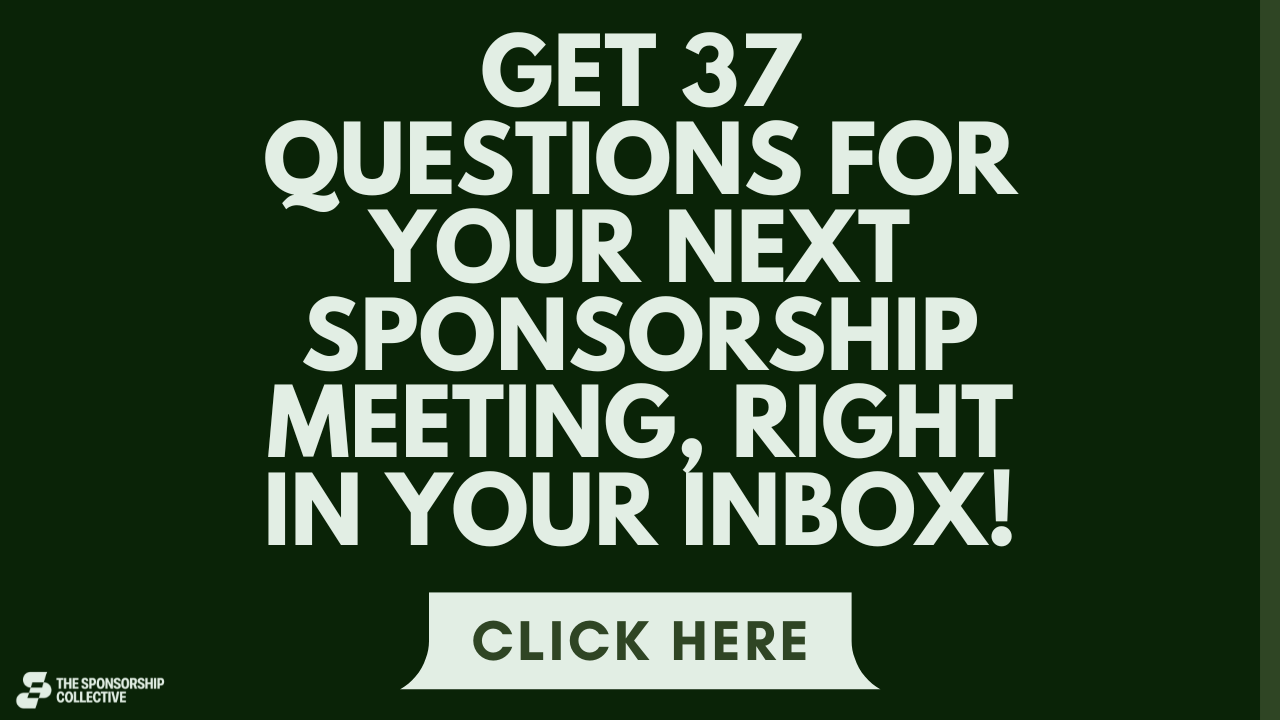Before you dive in, if you are interested in sport sponsorship, check out these titles in our “sponsorship for sports” series:
- Resource Page for Sport and Athlete Sponsorship
- How to Write a Sports Sponsorship Proposal
- The 7 Best Sports Sponsorship Activations
- 5 Examples of Bad Sports Sponsorships that Missed the Mark
- The Advantages and Disadvantages of Alcohol Sponsorship in Sport
- How do Sponsorships Benefit the Sports Organization and the Sponsor?
While many aspects of sports sponsorship such as assets and activations are intangible, whether your sponsorship deal was a success is very much a tangible thing. As your partnership wraps for the season, it’s your responsibility to sit down and calculate how lucrative said partnership was. What are some sports sponsorship metrics to track?
Pay attention to these metrics to gauge the success of your sports sponsorship:
- Tickets sold
- Number of television viewers
- Net Promoter Score
- Social media mentions
- Website traffic
- Leads generated
- Email open rates
- Email click-through rates
- Sponsor company sales
In this extensive guide, I’ll go through each of the 9 metrics above and explain the value of measuring them and how you can do that. This information will inform your sponsorship post-event report, so make sure you keep reading!
9 Sports Sponsorship Measurement and ROI Metrics That Matter
Tickets Sold
Sponsorship metrics are as much for you as they are for the sponsor company. They’re a chance to see who lived up to their end of the deal as outlined in your contractual agreement.
Your sponsor promised you a larger audience either through promotions or funding so you can put on a bigger sports event. By tracking the number of tickets sold, you can determine whether the sponsor did as they said.
You’ll have to compile the number of tickets sold both digitally (such as online) and in-person at the box office. Once you have this information handy, it’s time to do some comparisons.
If this sporting event is an annual one, were your ticket sales higher or lower than the same event in past years? If this is the first event of its kind, then compare your sales around this same time last year.
Your sports organization selling more tickets is advantageous to the sponsor as well. Higher ticket sales produce a larger target audience for the sponsor to work with.
Number of Television Viewers
Of course, not everyone who wants to can get tickets to attend your sporting events. Many more will watch the sport at home on television.
It’s time to dust off your Nielsen ratings, as you’ll be eager to see how your sponsored sporting event did on TV compared to non-sponsored games. Again, you want to compare your current sporting event to years past.
Did you earn several hundred new viewers? Several thousand? Hopefully, the answer is more in the ballpark of the latter than the former.
Just as with in-person attendees, it suits a sponsor if your event reaches a large mass of people. Perhaps one of the assets you sold your sponsor was X number of television slots during the race or game.
If more people watch your game, then that’s more sets of eyes on the sponsor’s commercial.
Net Promoter Score
While television viewers and sports attendees are great to have, those viewers/attendees could just be short-term.
That’s why tracking your Net Promoter Score or NPS is such a crucial sports sponsorship metric. You want an audience who’s sticking with you not only for one game but for the rest of your season and perhaps into the next season and the one after that, too. The NPS can predict customer loyalty.
I’ve discussed how the NPS works on the blog before, but if you need a recap, I’ll briefly go over the basics here. An NPS scores your sports audience members between 0 and 10. Depending on how each fan or viewer ranks your sports organization, they go into one of three groups.
The detractors rate you the lowest (0 to 6), the passives aren’t really swayed either way (scoring you a 7 to 8), and the promoters give the highest marks, usually a 9 or a 10.
When you tally up all your NPS scores, you’ll have a score as low as -100 to 100+. The goal is to have the most promoters in your audience, but since they’re giving you a nearly perfect score, that isn’t necessarily easy.
You want fewer passives than detractors, and as few detractors as possible. These groups are not loyal and, if anything, are dragging down your sports brand.
When a sponsor sees that your audience is loyal to your sports organization, that might encourage the sponsor to want to extend their deal with you. They know they’ll have another crack at your audience (which you’ve identified through research and discovery sessions is the sponsor’s target audience) during the next season.
Social Media Mentions
Are people talking about your sports organization on social media? If you’re lucky, the answer is yes. An increase in social media mentions proves that your sponsor’s promotional promises have come to fruition.
Rather than just being a blip on the radar, your sports organization is gaining traction. Your brand mentions have increased, which means your brand awareness has in kind. Due to the sponsor’s involvement, your sports organization is poised to grow.
A mutually beneficial partnership should have led to more social media mentions for the sponsor company as well. Don’t assume that just because they’re a bigger business than you (at least right now, they are) that they’re not interested in growth.
I’ve talked about this on the blog before, but even among the biggest brands in the world, there’s always room to collect new audience members. Your sponsor will want to grow too.
I don’t recommend refreshing social media search engines every five minutes and searching relevant hashtags. That’s too time-consuming. Rather, there is a bevy of marketing and social media tools (some of them free!) that can monitor specific hashtags and keywords.
Some tools are only for specific social media platforms such as TweetDeck while others will comb through your other social profiles.
Website Traffic
One of the signs of a fruitful sponsorship deal is an increase in website traffic for both parties.
Curious leads will search for your sports organization after hearing of your involvement with the sponsor. Your own audience searches for the sponsor after you announce a naming rights deal or a season-long partnership with the company.
A spike in website traffic will follow, but I must forewarn you that the traffic won’t be sustained on its own.
You’ll have a spike in traffic associated with the event that usually flatlines or goes back to its pre-event rates. That single spike alone isn’t enough to do more than maybe drive brand awareness. It certainly doesn’t result in conversions on its own, and it won’t increase sales either.
Instead, your website must be ready with opt-in forms and lead magnets to capture the lead’s contact information. That’s how you create sustained traffic.
Leads Generated
I always tell sponsorship seekers as well as all the readers on this blog that the most valuable asset you can offer a sponsor is your audience.
If your audience is full of consumers the sponsor is interested in reaching out to, and if the sponsor has products and services that suit the needs of your audience segments, then you and the sponsor are typically a fantastic match.
That said, what sounds good on paper must work in theory as well. If you tell the sponsor you can generate 500 shiny new leads, then that’s at least what they’re going to expect, perhaps more and only slightly less.
Google Analytics is a reliable means of tracking leads, as are the sponsor’s CRM, hidden form fields, etc. This information is not going to be available to you until you request it from the sponsor.
In the meantime, while you’re waiting on that data, be sure to track your sports organization’s own leads generated.
Email Open Rates
Do people care when you send an email? By tracking email open rates, you can answer that question definitively.
As the name implies, email open rates track how many of your audience members open your emails. Although you would think the number would be 100 percent, that’s not even close.
The average email open rate for the early 2020s is between 18 and 22 percent. That’s considered high.
In some industries, you still get higher or lower email open rates. In sports, the average open rate is slightly elevated at 24.57 percent. That means you’re aiming for a quarter of your audience to open your emails.
Open emails can boost engagement. You need your audience to open your emails to learn about when your sports team is coming to a city or town near them.
If your audience is engaging with you through opening emails, they’re likely also purchasing events to your games or watching you on TV. That then allows them to see the sponsor’s advertising, which might help them convert to the sponsor’s products or services.
Email Click-Through Rates
Email open rates are one thing, but they’re not as important without tracking email click-through rates as well.
An email click-through rate is how your reader interacts with the email. In other words, if you send a link to your sports schedule for the month in the email and that email has a high click-through rate, then most readers who received the email clicked the link.
Since links take readers to pages such as your merch store or your tickets site, it’s important to have a good click-through rate. To reiterate the point from the last section, a high click-through rate denotes more engagement with your audience, who might then be primed to begin engaging with your sponsor as well.
Click-through rates are smaller than email open rates, with a good rate between two and 10 percent. Again, email click-through rates do vary by industry. In sports, the average click-through rate you’re going for is 3.09 percent. That’s plenty achievable!
Sponsor Company Sales
Last but certainly not least, you want to track good, old-fashioned sales for the sponsor company. In working with you, how did their sales increase this month? This quarter? This year?
If your audience was a good match for the sponsor, then the sponsor company should have had a robust sales boost because of working with your sports organization. This is ROI in action; they put out X money towards your team, and now they hope to make Y back.
If you underdeliver on ROI, that is very likely the death knell for your relationship with the sponsor. That said, it can happen sometimes. Rather than try to shirk the truth, I recommend you try to assess what went wrong. This will better prepare you for your next sports sponsorship opportunity.
Conclusion
As in all other forms of sponsorship, sports sponsorship requires you to track measurement and ROI metrics to understand how successful your partnership was. The 9 metrics I discussed today will paint a clear picture to the sponsor whether you’re a viable candidate for a repeat sponsorship deal.
- About the Author
- Latest Posts
Chris Baylis is the Founder and Editor-in-Chief of The Sponsorship Collective.
After spending several years in the field as a sponsorship professional and consultant, Chris now spends his time working with clients to help them understand their audiences, build activations that sponsors want, apply market values to their assets and build strategies that drive sales.
Read More about Chris Baylis




